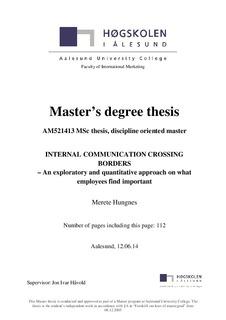Internal communication crossing borders - An exploratory and quantitative approach on what
Master thesis
Permanent lenke
http://hdl.handle.net/11250/275461Utgivelsesdato
2014Metadata
Vis full innførselSamlinger
Sammendrag
Communication and culture go hand in hand. The importance of both topics is exposed by the
enormous amount of research that has been done in their name. How these two topics
intertwine has also been given a great deal of attention, and there seems to be an agreement
that both topics require attention in corporate contexts. Compared to all the research done on
what is important for intercultural communication and what is important for internal
communication, the research done combining the two with the voice of the employees on the
front row is marginal.
That is what this thesis wanted to explore – what the employees of a multinational company
perceive as important for the internal communication, crossing cultural borders. The field to
be investigated was laid by selected research and other academic work highlighting different
aspects of either one or both of the topics. An exploratory design with a quantitative approach
was chosen as the right way to go, with the objective of reaching out to as many employees of
the chosen multinational company as possible.
The selected research seemed to fit the perception of the multinational company’s employees,
but not in the contexts originally anticipated, which was revealed by factor analyses. Even
though the initial take on the aspects were off, a good and relatively clear model revealed
itself. It turned out that successful intercultural-internal communication split into an
organizational and individual level, where different aspects explained either one or both of
these levels. Being familiar with cultural differences predicted the individual level best,
whereas what opportunities the channel presented in terms of storage, confirmation and
accessibility best foresaw the organizational level.
Based on the results obtained, the multinational company could take the employees’ opinion
into account, and see to that information on cultural encounters is easily accessed and
reached, to enable their employees to stay attentive and ready for the multicultural
environment they operate in.

